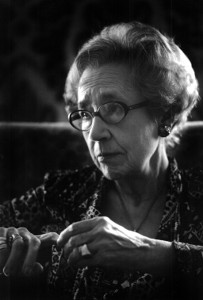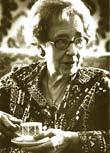Lydia Cabrera facts for kids
Quick facts for kids
Lydia Cabrera
|
|
|---|---|
 |
|
| Born | May 20, 1899 |
| Died | September 19, 1991 (aged 92) |
| Known for | Afro-Cuban poetry |
| Scientific career | |
| Fields | Anthropologist |
| Influences | European Vanguard |
| Influenced | Afrocubanismo Movement |
Lydia Cabrera (born May 20, 1899, in Havana, Cuba – died September 19, 1991, in Miami, Florida) was an important Cuban writer and researcher. She was known for her deep studies of Afro-Cuban culture. She focused especially on their religions and traditions.
Lydia Cabrera was an expert on Santería and other Afro-Cuban religions. She published over one hundred books during her life. Her most famous book is El Monte (which means "The Wilderness" in Spanish). This book was the first major study of Afro-Cuban traditions, plant uses, and beliefs.
El Monte was first published in 1954. It became a key book for people who practice Lukumi (an orisha religion from the Yoruba people) and Palo Monte (a faith from Central Africa). Both of these religions came to the Caribbean with enslaved Africans. Lydia Cabrera's writings helped people understand and respect Afro-Cuban culture and religion. She made valuable contributions to literature, anthropology, and art.
In El Monte, Cabrera fully described the main Afro-Cuban religions. These include Regla de Ocha (also known as Santeria) and Ifá, which come from the traditional Yoruba religion. She also wrote about Palo Monte, which started in Central Africa.
Cabrera's work helped turn spoken Afro-Cuban stories into written literature. Anthropologists use her detailed notes from interviews with religious leaders. They also use her descriptions of religious ceremonies.
Contents
Growing Up and Learning
Lydia Cabrera was born in Havana in 1899. She was the youngest of eight children. Her family was wealthy and well-known in Cuba. Her father, Raimundo Cabrera, was a writer and lawyer. He was also a strong supporter of Cuba's independence.
Lydia's father was the president of the first Cuban company. He also owned a popular magazine called Cuba y America. This is where Lydia first started writing. When she was thirteen, she wrote a weekly anonymous column for her father's magazine. She wrote about local news like weddings and births.
The Cabrera family had many Afro-Cuban servants and nannies. Young Lydia learned a lot about African stories, traditions, and religions from them. Like most wealthy Cuban children at that time, she had private teachers at home. She also briefly attended a private school. It was not common for women to get a high school diploma then. So, Lydia finished her education on her own.
Studies in Paris
By 1927, Lydia Cabrera wanted to earn her own money. She also wanted to be independent from her family. She moved to Paris, France, to study art and religion. She studied drawing and painting with a Russian artist named Alexandra Exter.
Cabrera lived in Paris for 11 years. She returned to Cuba in 1938. After finishing her studies, she did not become an artist. Instead, she decided to study Afro-Cuban culture. She was especially interested in their traditions and folklore.
While in Paris, she published her first book in 1936. It was called "Cuentos Negros" (Black Stories).
Exploring Afro-Cuban Culture
Lydia Cabrera was very interested in Afro-Cuban culture for most of her life. She learned about their stories from her Afro-Cuban nanny and seamstress when she was very young. Three things made her decide to study Afro-Cuban culture as an adult.
First, she saw how popular African art was becoming in Europe. Second, her studies in Paris showed her how much African art influenced Cuban art. Third, she had a friend named Teresa de la Parra. Teresa was a Venezuelan writer. They enjoyed reading Cuban books together and studying the island's culture.
Cabrera returned to Cuba in 1930 to deeply explore Afro-Cuban culture. She moved to a ranch near Havana. This ranch was close to the Pogolotti neighborhood. She did most of her research on Afro-Cuban culture there.
Between 1937 and 1948, she published her second book of short stories. It was called Por Que...Cuentos negros de Cuba. For this book, she joined in Afro-Cuban cultural events. She also recorded their religious rituals and traditions.
In the late 1950s, she kept publishing books about Afro-Cuban religions. She focused especially on the Abakuá. This was a secret society. The Abakuás were careful about sharing information about their religion. Since women were not allowed to be members, Cabrera used interviews to gather information for her book. Her book looked at the group's beginnings and their traditions. She even managed to photograph their sacred drum, which is usually kept hidden.
What Lydia Cabrera Wrote About
Lydia Cabrera's career lasted for many decades. She wrote before and after the Cuban Revolution. Even though she never formally studied anthropology, her work was very much like an anthropologist's. Her main goal was to focus on Afro-Cubans, who were often ignored. She wanted to give them a respected place in society.
Through her stories and images, she aimed to tell the history of the Cuban people from an Afro-Cuban point of view. Her work often blended what society called "fact" and "fiction." She wanted people to question what they had been told. In her book Afro-Cuban Tales (Cuentos Negros De Cuba), she wrote: "They dance when they're born, they dance when they die, they dance for killings. They celebrate everything!" This shows how Afro-Cuban stories connect to African traditions of celebrating life's big moments.
Moving to the United States
Lydia Cabrera left Cuba in 1960, shortly after the Cuban Revolution began. She never returned to her home country. She first went to Madrid, Spain. Later, she settled in Miami, Florida, where she lived for the rest of her life.
Ms. Cabrera received several honorary degrees. One was from the University of Miami in 1987. Cabrera called her stories "transpositions." This means she didn't just retell them. She changed and added to the African and universal folk tales. She also included details about Cuban customs from the 1800s and early 1900s.
In her later years, Lydia Cabrera worked hard. She edited and published many notes she had collected. These notes came from over thirty years of research in Cuba.
The exact reason she left Cuba is not fully known. Some people say she left because she did not like the new way of life the revolution was creating. Cabrera had often said she disliked the revolution's socialist ideas. Others believe she left because members of the Abakuá society were upset. They felt she had made their secret society too public. Whatever the reason, she stayed in Miami until her death on September 19, 1991.
See also
 In Spanish: Lydia Cabrera para niños
In Spanish: Lydia Cabrera para niños


